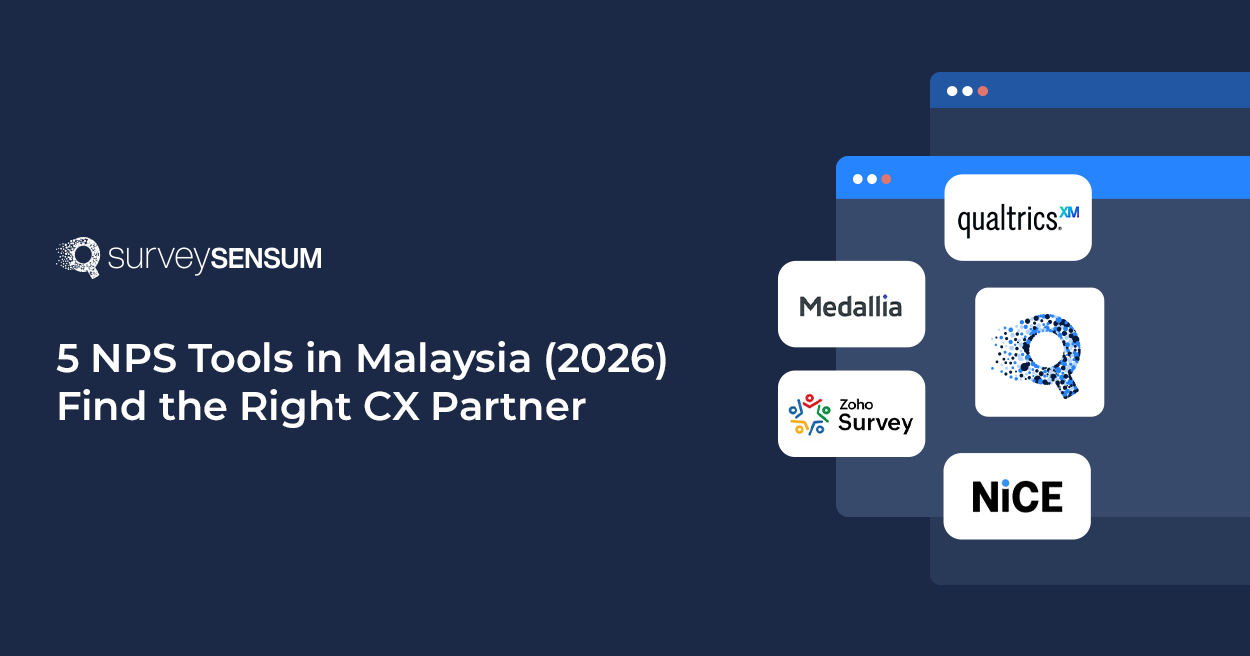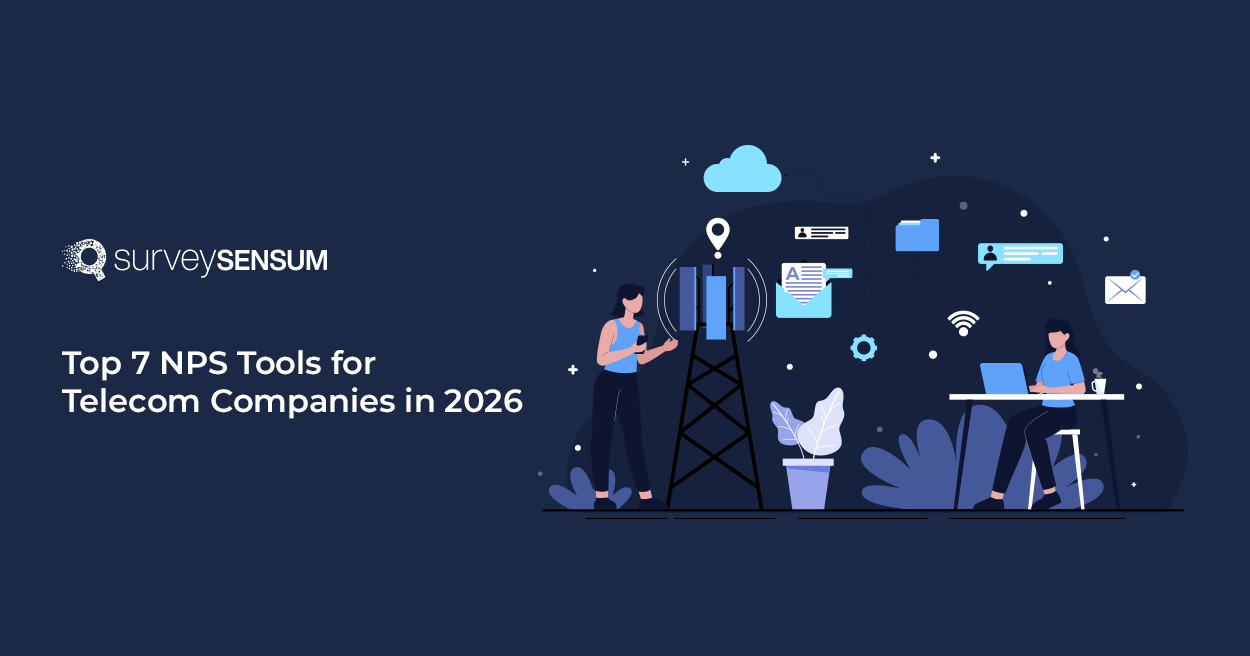

Patient Satisfaction Surveys in Healthcare – A Tell-All Guide
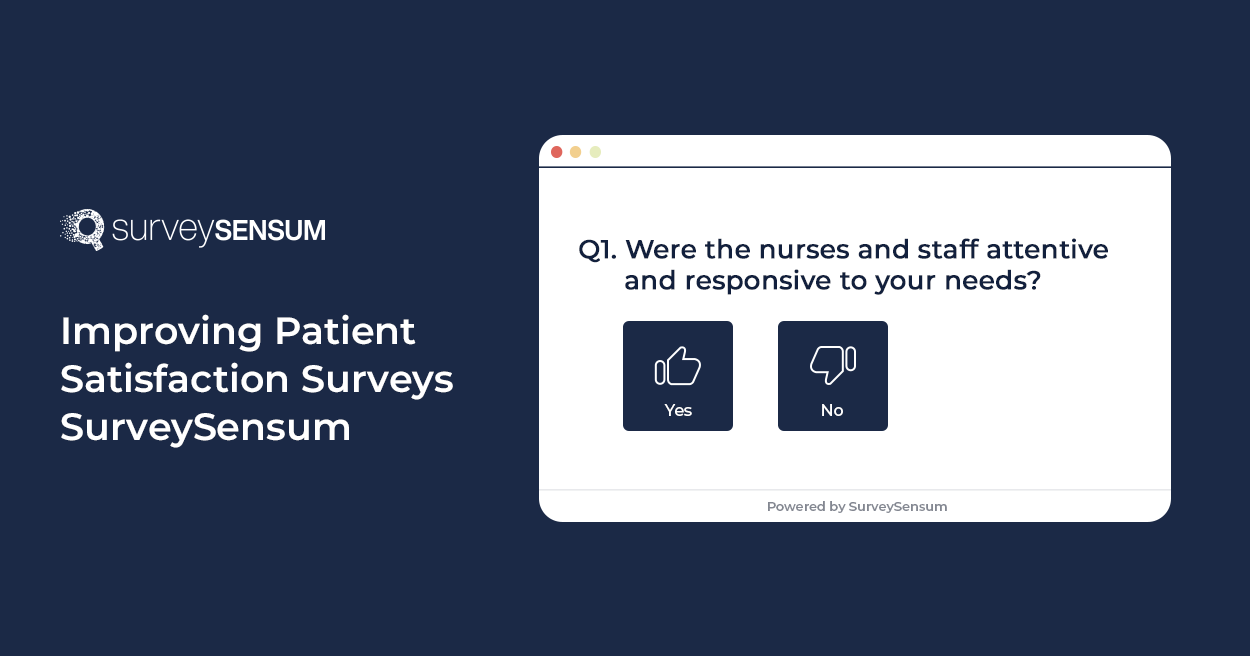
Every patient interaction is a chance to build trust and loyalty. In fact, 68% of the satisfied patients recommend their healthcare providers to others. On the other hand, dissatisfied patients can quickly spread negative feedback, affecting both your reputation and growth.
Therefore, by creating well-crafted patient satisfaction surveys at the right time, you can get rich insights into the patient experience, from appointment scheduling to post-care follow-ups.
By analyzing survey responses, you can spot recurring issues, fix communication gaps, and make meaningful improvements to the patient experience. That might mean cutting down wait times, improving how staff interact with patients, or making billing easier to understand. Well, in this blog post, I’ll walk you through everything about patient satisfaction surveys, their types, their key benefits, and how to integrate them effectively into your healthcare initiatives.
Understanding Patient Satisfaction
Patient satisfaction reflects how well a healthcare provider meets or exceeds patient expectations. It entails factors like medical care, facility experience, access to services, and communication. Patient experience at all touchpoints (waiting, doctor’s interaction, bill payments, wait time, etc.) can impact their satisfaction level.
A high patient satisfaction score means that patients trust their healthcare provider and receive high-quality care. Measuring patient satisfaction helps healthcare providers:
- Identify areas for improvement
- Enhance doctor-patient communication
- Reduce patient complaints and litigation risks
- Improve operational efficiency
- Build long-term patient relationships
What are Patient Satisfaction Surveys?
Patient satisfaction surveys refer to a structured set of questionnaires that are used by different types of healthcare organizations to capture rich insights about their healthcare experience at multiple stages of their visit.
Healthcare organizations can use data from patient feedback surveys with metrics like visit length, patient volume, wait time, and retention rate to identify areas of improvement and opportunities. The patient healthcare surveys mainly include questions about patient experience, quality of care, and access to patient facilities.
Now that we have talked about the patient satisfaction surveys, let’s take a look at their different types.
Types of Patient Satisfaction Surveys
Healthcare organizations use patient satisfaction survey outcomes to analyze their strengths and weaknesses. Therefore, the type of questions you choose to assess patient satisfaction can significantly impact the quality and the depth of feedback you receive.
Selecting the right type of survey totally depends on the type of healthcare institution and the touchpoint at which the feedback is collected.
Patient satisfaction surveys can be categorized into two key types:
1. Inpatient Satisfaction Surveys
These types of patients are people who are admitted to the hospital and receive treatment and medical care while staying overnight or for an extended period. To collect their feedback and get rich insight from their experience, you can launch an inpatient satisfaction survey. In this type of survey, you can add various questions like:
- How would you rate your overall experience during your hospital stay? (Excellent, Good, Fair, Poor)
- Were you satisfied with the quality of care provided by the medical staff? (Yes/No)
- How comfortable was your hospital room and environment? (Very Comfortable, Comfortable, Neutral, Uncomfortable, Very Uncomfortable)
- How would you rate the attentiveness and responsiveness of the nurses?
- Did the doctors explain your condition and treatment plan in a way you could understand?
2. Outpatient Satisfaction Survey
This type of survey entails folks who receive medical consultations and treatment services at the hospital without staying a night. They just visit the hospital for treatment and return home the same day. From this type of survey, you can collect info about their satisfaction level, experience of consultation, diagnosis process, and related services. Here are some questions that you can ask during this survey:
- How would you rate your overall experience at our facility? (Excellent, Good, Fair, Poor)
- Was it easy to schedule your appointment? (Yes/No)
- How long did you wait before seeing a doctor? (Less than 15 minutes, 15-30 minutes, 30-60 minutes, More than an hour)
- Did the doctor listen to your concerns and address them properly? (Yes/No)
- Did you feel that the doctor spent enough time with you during the consultation? (Yes/No)
- Were the nurses and support staff courteous and helpful? (Yes/No)
Now that we have talked about the main categories of patient satisfaction surveys, let’s discuss what benefits they offer.
Key Advantages of Using Patient Satisfaction Surveys
Patient satisfaction surveys are crucial for gathering patient experience insights to ensure satisfaction and attract new patients. If you have patient feedback in healthcare, you can build a transparent framework for benchmarking hospital performance across regions, incentivizing hospitals to enhance patient care quality.
Here are some other benefits of patient experience analysis and improving healthcare quality.
1. Get Real Insight Into What Customers Are Thinking and Make Your Institution Patient-Centric
No two patients are the same, and their experiences can vary widely, even within the same facility. A well-designed survey captures firsthand insights on aspects like wait times, doctor-patient communication, facility cleanliness, and overall comfort. According to the 2024 NRC Health report, patients who feel they are treated as unique individuals are 12 times more likely to recommend the healthcare system than those who don’t. This real-world feedback helps healthcare providers identify both strengths and areas for improvement.
2. Get a Chance to Improve Quality of Care
High-quality healthcare is also about delivering a smooth and compassionate experience. Patient satisfaction surveys highlight gaps in service delivery that allow hospitals and clinics to refine processes, enhance bedside manner, and optimize treatment protocols for better patient outcomes. In fact, only 38% of patients felt they were treated as unique individuals during their healthcare experience—a key driver of satisfaction and likelihood to recommend. This insight underscores the importance of using patient feedback to foster empathy-driven care and improve overall service quality.
3. Enhance Patient Retention and Loyalty
There is a high chance that a satisfied patient is more likely to return to the same healthcare provider and recommend the facility to others. Positive experiences build trust and loyalty. According to the 2024 NRC Health report, patients who rate their experience highly ( 9 or 10 on the NPS scale) are up to 87% more likely to reuse the same healthcare service, compared to just 66%–77% among those who gave a low score (0 or 1). This is crucial for private clinics and hospitals that rely on long-term patient relationships and word-of-mouth referrals.
4. Amplify Employee Performance and Morale
Patient feedback is valuable for management, doctors, nurses, and support staff to improve their interactions and service delivery. Positive feedback boosts morale, while constructive criticism offers learning opportunities that lead to professional growth.
5. Reduce Patient Complaints & Legal Risks
When patients feel unheard, they may feel frustrated. It sometimes leads to complaints or even legal action. Therefore, it is crucial for you to proactively collect feedback through surveys. It allows healthcare providers to address concerns before they escalate, fostering a more positive and transparent patient experience.
Now that we have talked about the benefits of measuring patient experience and offering patient-centered care, let’s talk about the right channels to share your surveys and at what touchpoints you can share them.
What are the Right Channels and Time to Share the Patient Satisfaction Surveys?
Sharing patient satisfaction surveys across multiple channels and touchpoints is no longer just a good idea – it’s essential. With omnichannel feedback management, you go beyond traditional strategies by capturing insights from every patient interaction.
This 360-degree approach empowers you to drive better healthcare outcomes, enhance patient loyalty, and maximize your ROI.
The result? Smarter, faster, and more informed decisions for your organization.
So, here are some examples of different channels on which you can share your surveys at different touchpoints.
1. Offline Surveys
If you want real, timely patient feedback, you need to go offline. Strategically placed in reception areas, patient rooms, and waiting rooms, offline surveys make sharing feedback effortless. With a survey app, responses are collected without internet access, securely stored, and synced later. They work because:
- They are always accessible, even in areas with poor connectivity.
- They offer a smooth experience, and patients can respond at their convenience.
- They are HIPAA-compliant and ensure data privacy and security.
- They offer actionable insights to help improve care in real time.
Best Timing: The best timing for an offline survey is immediately after the patient’s visit, while they are still at the facility, to capture fresh and accurate feedback.
2. Email Surveys

Email surveys are a hassle-free way to collect feedback after a patient’s visit. You can add the first question right inside the email to encourage quick responses or include a survey link in routine emails like receipts or reports, making it easy for patients to share their thoughts without any extra effort. They work because:
- They allow patients to respond at their own pace.
- They encourage higher engagement and boost participation.
- They can easily integrate with easy access.
Best Timing: The best timing would be 24–48 hours post-visit, when the experience is still fresh in the patient’s mind.
Design personalized surveys, embed them directly into your email campaigns, and track responses in real-time with SurveySensum!
3. SMS Surveys
Do you know that the average open rate for an SMS campaign is 98%, 5x that of email (20%)? Therefore, SMS surveys have become the most effective way to engage with patients quickly. Here’s why they work:
- Patients can respond in seconds, anytime, anywhere.
- Short, mobile-friendly surveys boost completion rates.
- Instant feedback helps you address concerns quickly.
- Easily integrate with patient management systems.
Best Timing: The best time to send the SMS survey is within a few hours after the appointment, before patients get too busy or forget their experience.
4. In-App or Patient Portal Survey
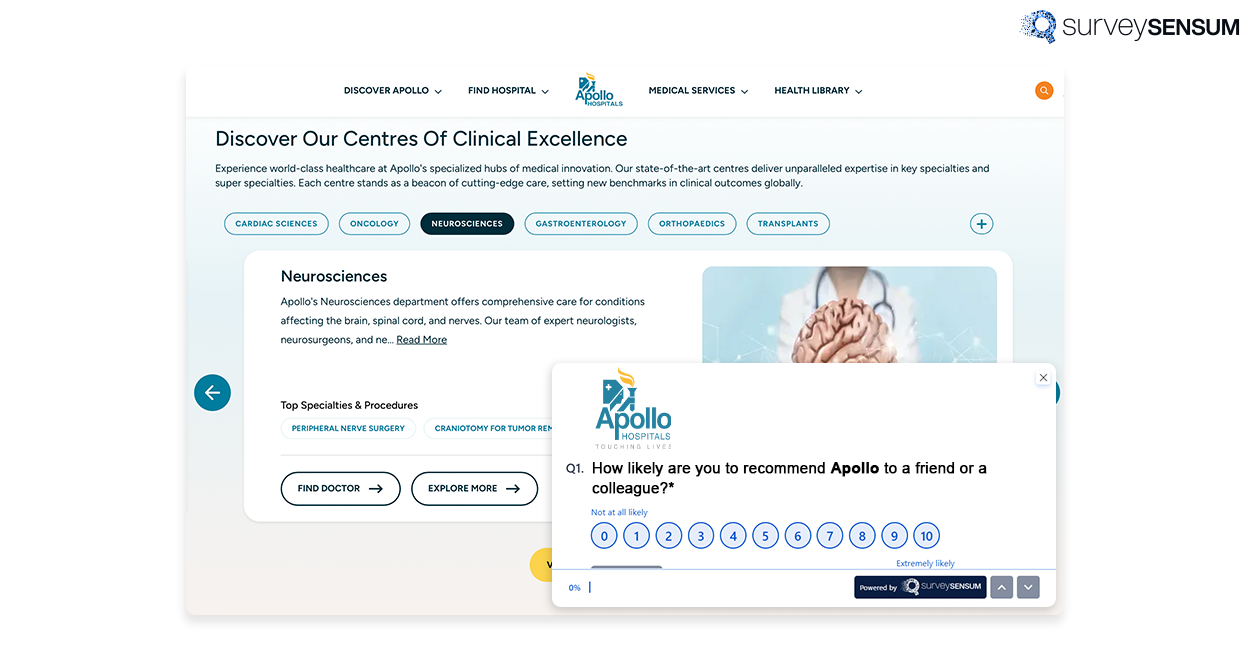
If your healthcare facility has a patient portal or mobile app, embedding surveys directly in these platforms ensures a stellar experience for patients. This type of survey works because:
- Surveys fit naturally into the patient’s digital experience without feeling like an extra step.
- Patients already using the portal are more likely to participate.
- Captures responses when the visit or test results are still top of mind.
- Easy to complete on smartphones, boosting response rates.
Best Timing: Immediately after a patient logs in post-visit or receives test results.
5. QR Code Surveys

Patients can now easily share their feedback instantly with a simple QR code scan in their room. This easy process lets them access the survey on their smartphone, ensuring convenience and timely insights. Their input helps enhance care quality and make your facility more patient-centered and responsive. Here’s why they work:
- No need for emails or links—patients can scan and respond in seconds.
- Capture impressions while the experience is fresh.
- Simple, mobile-friendly processes increase participation.
- Patients can complete the survey at their own pace before leaving.
Best Timing: 2–3 days after the visit, when the patient has had time to reflect on their experience.
6. WhatsApp Surveys

WhatsApp surveys offer a quick and convenient way for patients to share feedback. Healthcare providers can send short text-based surveys or links, and it makes it effortless for patients to respond anytime. Here’s why it works:
- Patients already use WhatsApp daily, reducing friction.
- Surveys are easy to complete in just a few taps.
- Higher response rates due to instant delivery increase participation.
- Fast feedback helps improve services promptly.
Best Timing: 24–48 hours after the visit, while the experience is still fresh.
7. Website Survey
The other great way to collect patient feedback is a website survey during appointment booking or when patients are looking for healthcare services. There are different ways in which you can collect feedback on the website in the form of widgets like popup surveys, slide-up surveys, and feedback buttons. Here’s why it works:
- Capture feedback in the moment for more accurate responses
- Encourage participation through easy, non-intrusive formats
- Build trust by showing patients their opinions matter
- Offer quick insights to improve the website and service experience
Best Timing: The best time to trigger a website survey is during or right after the appointment booking process, when engagement is highest.
Capture Fast, Focused Feedback with SurveySensum’s Website-Embedded Surveys!
Now that we have talked about the right channels to share the patient satisfaction surveys, let’s talk about some of the examples.
Key Patient Satisfaction Survey Examples
Patient satisfaction surveys are a powerful way to understand what’s working for you and what needs improvement. Here are some crucial examples of patient satisfaction surveys that you can use as a template.
Hospital Post-Consultation Feedback (Inpatient & Outpatient)
- How would you rate the quality of care you received during your visit?
- Were the nurses and staff attentive and responsive to your needs?
- Was your room (or waiting area) clean and comfortable?
- Did you feel informed about your treatment or procedure?
- Was the discharge process smooth and timely?
- Is there anything we could improve to make your experience better?
Post-Visit Survey Template for Clinics or Healthcare Facilities (Outpatients)
- How easy was it to schedule your appointment?
- Was your wait time reasonable?
- Were you satisfied with the time the doctor spent with you?
- Did our staff treat you with courtesy and respect?
- Was it easy to understand your diagnosis and next steps?
- Would you choose our clinic again for future care?
Patient Feedback About Doctor Survey
- Did the doctor listen carefully to your concerns?
- How clearly did the doctor explain your condition or treatment?
- Did you feel comfortable asking the doctor questions?
- Was the doctor respectful and empathetic during the consultation?
- On a scale of 1–10, how would you rate your overall experience with the doctor?
- Any suggestions to help us improve your interaction with our doctors?
If you need a detailed survey question template, find it here.
How SurveySensum Can Help Set Up an Effective Patient Feedback System?
Building solid patient feedback is about designing meaningful interactions, collecting rich insights, and using them to drive real improvements in patient care. Here’s how SurveySensum helps you do exactly the same.
1. Understand Your Audience & Why You’re Doing It
Before creating a single question, get a clear understanding of your goals and ask yourself these questions: Are you measuring post-consultation satisfaction? Are you trying to reduce appointment wait times? Improve doctor-patient communication?
Through the SurveySensum onboarding or the CX consultation process, you can help define what matters most, and your feedback system is aligned with actual outcomes like trust-building, loyalty, and improved treatment adherence.
2. Build Smart, Contextual Surveys with Survey Builder

Using SurveySensum’s drag-and-drop Survey Builder Tool, you can create custom surveys in minutes — whether it’s an NPS, CSAT, or CES survey. For healthcare providers, you can:
- Set up Post-Visit Feedback Surveys that pop up via WhatsApp or email right after a patient leaves.
- Collect Doctor-Specific Feedback with Custom Fields.
- Use condition-based logic (skip logic and branching) so surveys feel personalized, not generic.
You don’t need a degree in UX or survey science — their pre-built healthcare templates already follow best practices.
3. Distribute Surveys Where Patients Actually Are

SurveySensum doesn’t limit you to emails. You can send surveys through SMS, WhatsApp, in-app prompts, or even embed them into portals. So whether you’re reaching Gen Z on their phones or elderly patients via email, your feedback touchpoints feel natural, not forced.
4. Know What Your Patients Feel with AI-Powered Feedback Analysis

SurveySensum goes beyond collecting responses, it helps you truly understand them. Its AI-driven text analytics engine doesn’t just display charts and percentages. It digs deep into open-ended feedback to detect emotional tone, intent, urgency, and key themes, all in real time. So you can:
- Instantly flag high-risk experiences (like complaints about staff behavior or billing confusion)
- Detect emotional tone and sentiment in open-ended responses instantly
- Track sentiment changes over time to measure impact of service improvements
- Monitor trends (like rising dissatisfaction with appointment wait times)
- Track sentiment over time for specific departments or doctors
5. Close the Loop Automatically
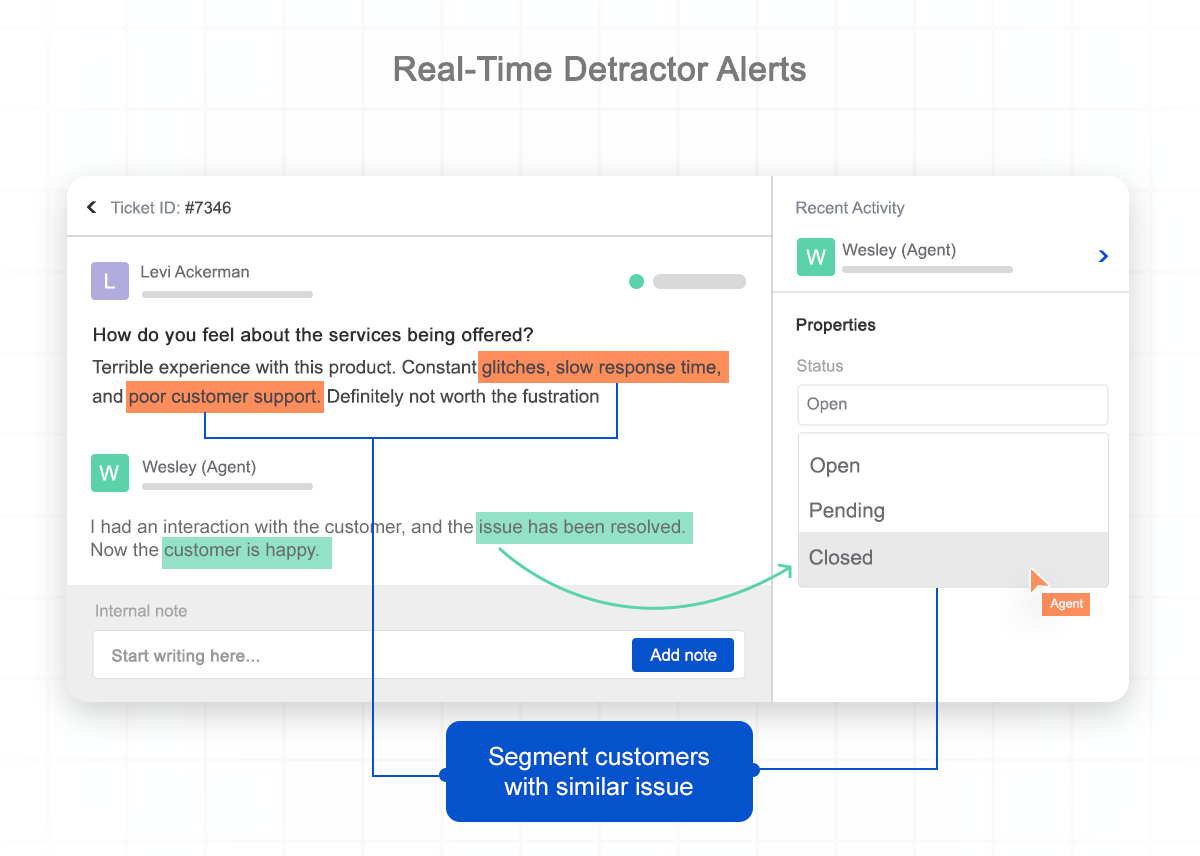
Most feedback systems fail because responses vanish into a black hole. Not with SurveySensum. Its closed feedback loop ensures that low scores and negative sentiment trigger real-time alerts, so your care team can step in quickly to acknowledge and resolve issues. SurveySensum’s AI-powered ticketing system flags critical feedback and routes it to the right team for fast action. Every issue is tracked to closure, so nothing gets missed and patients feel heard. You can also automate thank-you messages or fo
follow-up reminders to keep the experience smooth and personal.
6. Collaborate & Take Action with Internal Teams
SurveySensum doesn’t just show you numbers — it lets you share insights across departments, assign action items, and track resolutions. Whether it’s front-desk staff needing retraining or delays in billing, you can make every patient voice count in internal process improvements.
Conclusion
Delightful patient care starts with genuinely understanding your patient’s needs and experiences. SurveySensum offers you a robust way to set up an effective system for gathering and analyzing patient feedback. By actively listening to your patients and taking action on their feedback, you can increase patient loyalty, boost patient satisfaction, and amplify staff performance.
Transform Your Patient Feedback Into Actionable Insights With SurveySensum Today!
Frequently Asked Questions on Patient Satisfaction Survey
Surveys are short questionnaires sent post-visit (via email, SMS, or WhatsApp) to gather insights on everything from wait times to staff behavior.
Use a mix of CSAT, NPS, and open-ended questions. Real-time dashboards and sentiment analysis tools help turn responses into actionable data.
They highlight patterns in patient complaints or praise, helping healthcare teams enhance services and boost satisfaction across departments.
Hospitals often involve multiple touchpoints—admissions, surgery, and recovery—so surveys need to be more detailed and multiphase.
Absolutely. They reveal what’s working, what’s not, and what keeps patients coming back—essential for scaling and reputation-building.
By identifying what drives loyalty—like communication, empathy, or shorter wait times—you can design better patient loyalty strategies.













